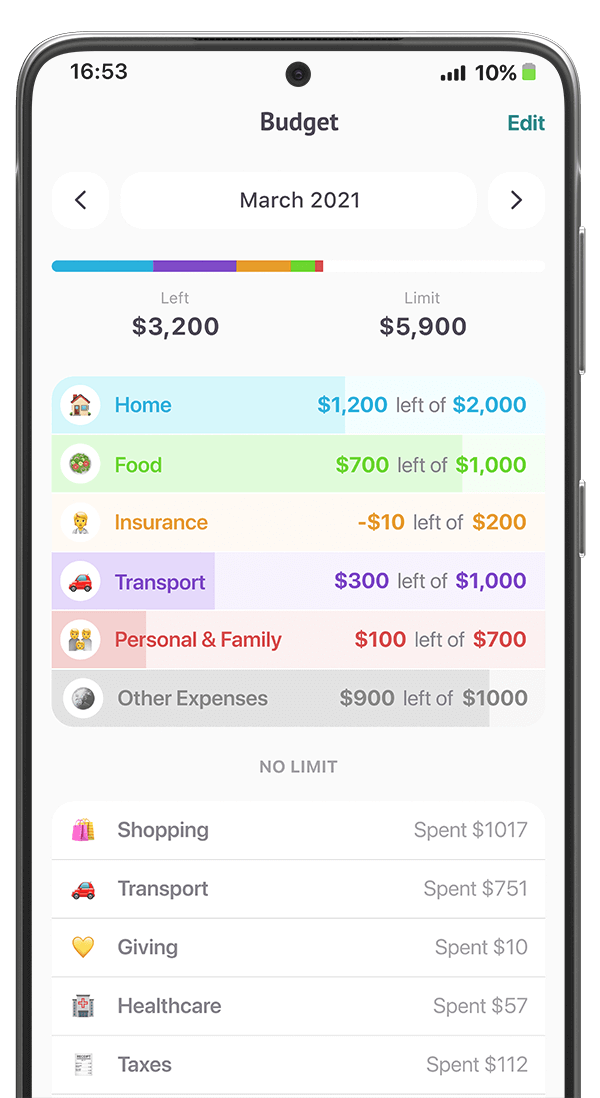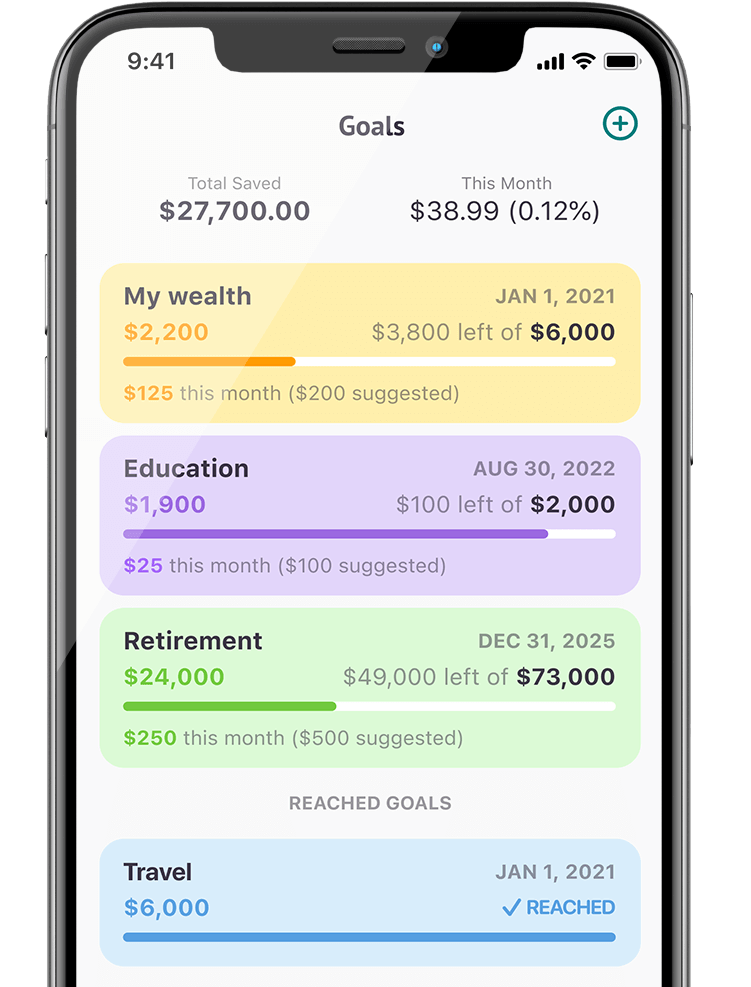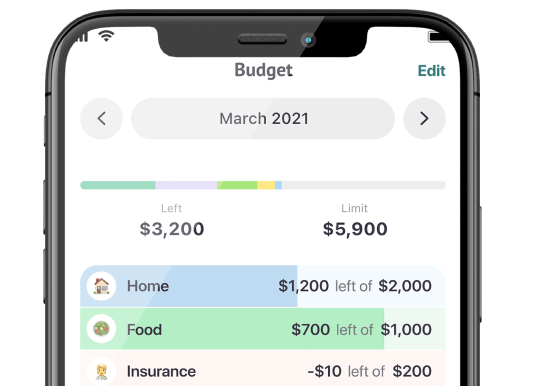You probably have a portfolio already, even if you’re not actively planning and managing it. Since a portfolio is simply a collection of financial assets, technically, something as simple as a savings account can be part of one. There’s a big difference between just “having assets” and intentionally creating a portfolio to help you save towards a goal, though, and the latter is what we’ll be looking at here. As complex, as it might look at first glance, setting up a good investment strategy, can actually be quite simple if you use some of the easy options (like Robo-advisors!) available to you. Either way, there are a few major steps you should run through if you want to build a portfolio:
- Identify your goals so you know what you’re aiming for.
- Assess your financial situation so you know where to start.
- Determine your risk tolerance so you know how aggressive your investing strategy should be
- Use your risk tolerance and goals to estimate your ideal asset allocation—e.g., 40% bonds/60% stocks.
- Create an ongoing management strategy to ensure you keep contributing and keep your portfolio on track towards your goals.
Step 1: Identify your goals

One of the most common investment goals is retirement, and for good reason: investments given a few decades to grow can easily end up at several times their initial value. For example, saving $500 a month for 40 years with an average of 7% returns will leave you with around 1.5 million dollars, though your actual deposits into your investment accounts will have added up to just about $240,000. That’s over six times your initial investment!
Portfolios aren’t just for retirement, though—you can have multiple goals and build a separate portfolio for each one. Short and medium-term goals won’t get you quite the same level of returns, but putting together a simple investment plan will get you noticeably further than keeping your savings in a checking or savings account.
Common goals include:
The most important thing about these goals is their time horizon. The closer they are, the more conservative you should be with your savings. Something that’s 15 years down the line can handle a lot more ups and downs than a goal that’s just two years away, so you can invest in riskier things that may yield higher returns in the long run. This will be important when you’re deciding on your initial investment strategy and how the balance of assets you hold will change as your goal gets closer.
Different goals will also require different types of accounts to hold your assets. Lots of tax-advantaged options (with certain conditions) exist for retirement, like IRAs, 401(k)s, HSAs, etc. Likewise, for education savings, you have options like ESAs and 529s. For most other types of savings, you’ll typically have to keep your investments in a taxable brokerage account, which means you will have to pay taxes, but you can withdraw the money whenever you need it.
In general, savings for short-term goals are best kept in high-yield savings accounts or certificates of deposit (laddering is a strategy that can help keep these growing as well as fairly liquid!), medium-term goals can be held in savings or relatively safe investments, and long-term goals can be held in accounts with more stocks and other risky instruments.
Step 2: Assess your financial situation

Whether you build your first portfolio to start with investing or you’ve been doing it for years, getting an accurate picture of your finances will help you make better decisions. If you’re using an app to help you track your money, you may already be able to see your assets, liabilities, income, and expenditures all in one place. If you prefer to do it manually, you should catalog your assets and liabilities on a balance sheet and your income and expenditures on a cash flow statement. From there, you can identify your next move by running through a few questions:
- Do you have high-interest debt to pay off, like credit card debt?
If you’re carrying a credit card balance, you might be paying a 20%+ interest rate on it. Very few investments can guarantee anything like that rate of return, so you’ll benefit more by paying this off before you start investing. Lower-interest debt is also something you should be trying to pay off, but it can be a longer-term goal.
- Do you have an emergency fund?
It’s generally a good idea to have at least 3-6 months of living expenses saved up before you start investing and build a portfolio. If you go into debt because of a financial shock you may have to liquidate your investments anyway, plus you could end up paying interest and lowering your credit score.
- If you’re saving for retirement, do you have a 401(k) with employer matching?
If you have a 401(k) with an employer matching your contributions, it should probably be your primary investment vehicle. Max this out before investing anywhere else, as you’re essentially getting an immediate 100% return on your investment.
If you don’t have a 401(k), or have one that your employer doesn’t match, an IRA is probably a good choice for your retirement savings. If you expect to make more in the future than you do now, a Roth IRA is best for you, as you pay into it with after-tax income. If you expect to make less in the future, a Traditional IRA is tax-deferred, meaning you can choose to pay taxes later, when you’ll be taxed at a lower rate.
Step 3: Determine your risk tolerance

Your risk tolerance describes how much volatility you’re willing to have in your investments. As a general rule, risky portfolios tend to contain more stocks and safe ones tend to contain more bonds, also referred to as fixed-income securities. We’ll look more at asset types in the next section. Your risk tolerance, though, depends on a few different factors:
- How far away is your goal?
The rule of thumb here is fairly simple: the closer the goal is, the more conservative portfolio you should build. For long-term goals like retirement, that might mean gradually increasing the share of bonds in your portfolio over time. For short-term goals, that might mean holding most of your savings in a savings account.
- What is your financial situation?
If you have an emergency fund and are fairly comfortable with your savings progress, you might be okay with taking some risks. As the saying goes, only gamble with what you can afford to lose. If a sudden drop in the market would negatively impact you, you should probably be moderate with your portfolio risk. In the long run, a well-diversified risky portfolio will generally have enough gains to compensate for losses, but for short-term goals, you should focus on relatively stable assets like bonds and cash/cash equivalents.
- How do you handle short-term losses?
Imagine you’ve been investing for a while and the stocks in your portfolio have been doing very well, earning over 10% for a few years in a row. Suddenly, the market takes a dip, a year’s worth of gains is wiped out overnight, and it looks like the losses are going to keep piling up. Do you a) sell to protect your remaining gains or b) hold your current assets and continue to invest at the same rate?
If you would sell, you’re probably a more loss-averse investor and might do better in the long-term with more stable assets that won’t fluctuate and cause you mental or financial strain. If you would hold and continue investing without being too bothered by the loss, you may see higher long-term gains by taking on riskier assets.
Step 4: Identify your ideal asset allocation
Your portfolio’s asset allocation just describes the breakdown of assets in your portfolio—70% stocks, 30% bonds, for example. At one extreme, you could have an asset allocation of 100% cash, keeping all your money in a savings account. This might protect your money against inflation, but you won’t get significant returns. On the other end of the spectrum, you could invest exclusively in high-risk securities that could either go to zero or through the roof.
In general, though, you want to be between those two extremes. Your goal’s timeline and risk tolerance are important here: the closer your goals and the lower your risk tolerance, the more conservative your portfolio you should build. If you’re using a human financial advisor or a Robo-advisor they’ll generally help you figure out your tolerance and automatically buy bundles of assets that fit you.
If you’re doing it manually, a good rule of thumb is that the percentage of stocks in your portfolio should be equal to about 110 – [your age]. A 30-year-old might have 80% stocks and 20% bonds, for example, while a 60-year-old would have 50% stocks and 50% bonds. If you’re a more conservative investor, 100-[your age] gets you a lower ratio of stocks. What does that actually mean, though? Here’s a quick rundown of some of the most popular investment instruments:
Cash
Cash doesn’t grow much, but it provides safety and liquidity in case your other investments don’t do so well. If you’re more conservative or your goal is getting close, keeping 10-30% of your funds in cash can be a good idea. If you’re just starting or have a higher risk tolerance, you can go as low as 2-5%, as long as you have at least a six-month emergency fund on hand.
Stocks/Equities
Stocks are shares in individual companies that change in value depending on how that company is perceived. While they can be risky, portfolios containing a wide variety of stocks have historically gone up over time (averaging 10% returns since 1926) and they’ll likely continue to do so, though you’ll probably encounter large dips in the market and possibly see some of your investments fail.
The growth potential of stocks makes them a great choice if your goal is far enough away that you aren’t worried about the short term. Aggressive/long-term investors might want 80-100% of their investments to be in stocks, while conservative/short-term investors probably want to aim for under 50%. Following the 110-[your age] rule means you’d have about 90% stocks at age 20 and about 40% stocks at age 70.
Bonds/Fixed-income securities
Bonds are debts that companies or governments promise to pay off over time, generally at a set interest rate. They’re considered safer than stocks and provide a more predictable return, but they don’t pay off as much over time, averaging around 6% yearly returns since 1926.
If your goal is getting closer or you just want to build a conservative portfolio, including up to 70-80% bonds is a good way to keep your money safe, but growing. If you’re starting on a long-term goal or want to be more aggressive, the share of bonds might be as low as 10-20% of your portfolio. For retirement, the 110-[your age] rule will put you between 10% and 60% bonds between the ages of 20 and 70.
Funds: Easy diversification
To build your own diversified portfolio of individual stocks and bonds is a fairly advanced investment strategy and will take a fair bit of time and research. That’s why mutual funds, index funds, and ETFs (exchange-traded funds) are some of the most popular investment instruments. They differ in some details, but they all run on the same basic idea: each fund contains a basket of stocks, bonds, and/or other assets, and its value changes depending on the value of those assets.
This means that, with a single purchase, you can get a curated selection of assets that will be maintained and adjusted for you. Many of them do come with fees, but the quick diversification and easy management can be well worth it. That’s why, whether you build your own portfolio or someone else is doing it for you, the majority of your investments are likely to be held in mutual funds, index funds, and/or ETFs.
Other assets
Stocks and bonds are the meat and potatoes of the investing world, but real estate, commodities, futures, derivatives, cryptocurrency, and other assets are also legitimate things to include in your portfolio. They tend to be more complex and carry more risk, which is why they’re typically handled by professionals or experienced investors, but if you want to take an active role in managing your portfolio, putting a few percent of your portfolio into these assets may yield good returns.
Step 5: Develop a management and rebalancing strategy
Management: Hands-on or hands-off

As mentioned above, you have two primary options for managing your portfolio: do it yourself or pay someone else to do it for you.
If you choose to manage your own money, it’s easiest to use your investment accounts to buy mutual funds, index funds, and ETFs in ratios that match your goals. This way, it’s fairly simple to calculate your percentage of stocks to bonds and adjust them over time. You’ll still have to pay fund management fees with this strategy, though—if you want to avoid those, you’ll have to buy individual stocks and bonds and diversify on your own.
The alternative is to use either a human financial advisor or a Robo-advisor to build and maintain your portfolio. Human advisors can be expensive but may be worth it if you have a lot to manage or special circumstances. Robo-advisors are cheaper, taking only 0.25%-0.5% per year, but your service won’t be quite as personalized. Both types, though, will take care of pretty much everything except making deposits. Once you set your goals and risk tolerance, they’ll buy a mix of assets for you whenever you put in money and then adjust your portfolio when it needs to be changed.
Rebalancing
If you’re going the DIY route, you’ll have to periodically rebalance, meaning you ensure that the percentage of stocks to bonds in your portfolio hasn’t changed too much. If you’re aiming for 40% bonds/60% stocks and actually have 35% bonds and 65% stocks, for example, you’ll need to either sell some stocks and use the money to buy bonds, or invest enough money in bonds that the balance is restored.
You should aim to do this every 6-12 months, or, if you’re taking a more active role, whenever one of your asset classes shifts up or down in value by more than some percentage—say, 5%. If you have a financial advisor, they’ll probably take care of all this for you.
Wait, that’s not simple!
Just as you don’t need to know programming or computer engineering to use a computer, you don’t need to know the ins and outs of finance and asset classes to benefit from investing. Knowing more and putting in more time can definitely help you build a better portfolio, but there’s nothing necessarily wrong with sticking to the basics. As complex as it looks when you dig into it, starting up a basic portfolio can be done in a few hours or less, and the eventual payoff can end up being very worth it.
Simplest: investing with an advisor
- Set up an account with a human advisor or a robo-advisor.
- Set your risk tolerance and any other information that affects your investing strategy.
- Deposit money regularly (at least 10% of your income every month if you can). The advisor will invest it for you.
- Check on your portfolio at least every few weeks or months to make sure you’re on track.
Moderately difficult: self-directed investing:
- Open an investment account (Roth IRA, brokerage account, 529, etc.).
- Calculate your asset allocation (basically, the percentage of stocks vs percentage of bonds).
- Buy mutual funds, index funds, or ETFs to get the stock/bond ratio you need. Make sure to check management fees!
- Invest at least 10% of your income every month.
- Check back every 6-12 months and rebalance.
Managing your finances well definitely takes work, but managing a portfolio is only as complex as you want it to be. Even the simplest investing strategy will leave you with very respectable returns if adhered to over the long term. Once you get started, the key is simply sticking to your plan.











